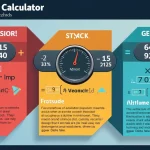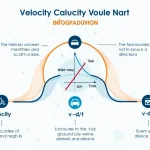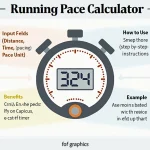Velocity Calculator
Is this tool helpful?
How to Use the Velocity Calculator Effectively
Our user-friendly Velocity Calculator simplifies solving motion problems by allowing you to calculate velocity quickly and accurately. Follow these steps to make the most out of this powerful physics tool:
1. Enter the Required Values
Input the specific parameters based on your calculation needs. For example, to calculate velocity, fill in the fields below:
- Displacement: The total distance traveled, e.g., 250 meters or 1,500 meters.
- Time: The duration over which the displacement occurred, e.g., 25 seconds or 300 seconds.
2. Click the Calculate Button
Once you’ve entered the values, simply press the “Calculate Velocity” button. The calculator instantly computes the velocity using the formula and displays the result with proper units.
3. Review the Step-by-Step Solution
Below the result, you’ll find a detailed breakdown of the calculation steps, which helps you understand the process and verify your work.
4. Analyze the Motion Graph
Visual learners can explore the generated graph that illustrates displacement over time, reinforcing the relationship between velocity, time, and displacement dynamically.
Introduction to the Velocity Calculator: Definition, Purpose, and Benefits
The Velocity Calculator is an essential physics tool designed to calculate the velocity of an object based on its displacement and the time taken. Velocity, a key concept in motion analysis, represents the rate at which an object changes its position, and is vital across numerous fields including education, engineering, sports science, and environmental studies.
By automating the calculation process, this tool eliminates errors inherent in manual computations while providing instant, accurate results. Whether you are a student learning principles of motion or a professional analyzing velocity data, this calculator enhances efficiency and precision.
Key benefits include:
- Time-saving: Quickly computes velocity without lengthy calculations.
- Accuracy: Minimizes human errors ensuring reliable results.
- Step-by-step explanations: Helps users understand the problem-solving process.
- Graphical visualization: Offers a clear visual relating displacement and time.
Example Calculations Using the JavaScript Velocity Calculator
The Velocity Calculator uses the simple but fundamental formula:
Velocity = Displacement ÷ Time
Here are two practical examples demonstrating the calculator’s functionality:
Example 1: Calculating Velocity for a Delivered Package
- Displacement: 600 meters
- Time: 120 seconds
The calculator computes velocity as:
$$v = \frac{600}{120} = 5 \text{ m/s}$$This means the package was traveling at 5 meters per second during delivery.
Example 2: Estimating Velocity of a Runner
- Displacement: 800 meters
- Time: 100 seconds
Calculation performed by the tool:
$$v = \frac{800}{100} = 8 \text{ m/s}$$The runner’s velocity is therefore 8 meters per second.
Understanding the Output
The calculator provides the numerical velocity value along with a clear unit of measurement (meters per second). Additionally, you will receive a detailed step-by-step solution illustrating the computation and a graph plotting displacement versus time to help visualize the motion.
Why Use a Velocity Calculator for Motion Analysis?
Velocity is fundamental to understanding and predicting the behavior of moving objects. Using a reliable Velocity Calculator benefits users by:
- Improving conceptual understanding: Stepwise results reinforce how velocity relates to displacement and time.
- Enhancing learning efficiency: Saves time for students and teachers by automating calculations during homework or demonstrations.
- Facilitating professional analysis: Engineers, sports analysts, and environmental scientists can make precise calculations quickly.
- Providing visual insights: Graphs help users interpret and analyze motion patterns effectively.
Additional Features for Deeper Learning and Application
Step-by-Step Calculation Guide
Each calculation is accompanied by a clear explanation breaking down how the formula is applied with your specific inputs, supporting educational goals and self-learning.
Real-Time Validation
The calculator ensures valid inputs by alerting users if values such as negative time or displacement are entered, maintaining the correctness of computations.
Dynamic Motion Graphs
Visual charts plot displacement against time based on entered values, allowing users to directly observe motion characteristics such as uniform velocity depicted by linear displacement increase over time.
Important Disclaimer
The calculations, results, and content provided by our tools are not guaranteed to be accurate, complete, or reliable. Users are responsible for verifying and interpreting the results. Our content and tools may contain errors, biases, or inconsistencies. We reserve the right to save inputs and outputs from our tools for the purposes of error debugging, bias identification, and performance improvement. External companies providing AI models used in our tools may also save and process data in accordance with their own policies. By using our tools, you consent to this data collection and processing. We reserve the right to limit the usage of our tools based on current usability factors. By using our tools, you acknowledge that you have read, understood, and agreed to this disclaimer. You accept the inherent risks and limitations associated with the use of our tools and services.







